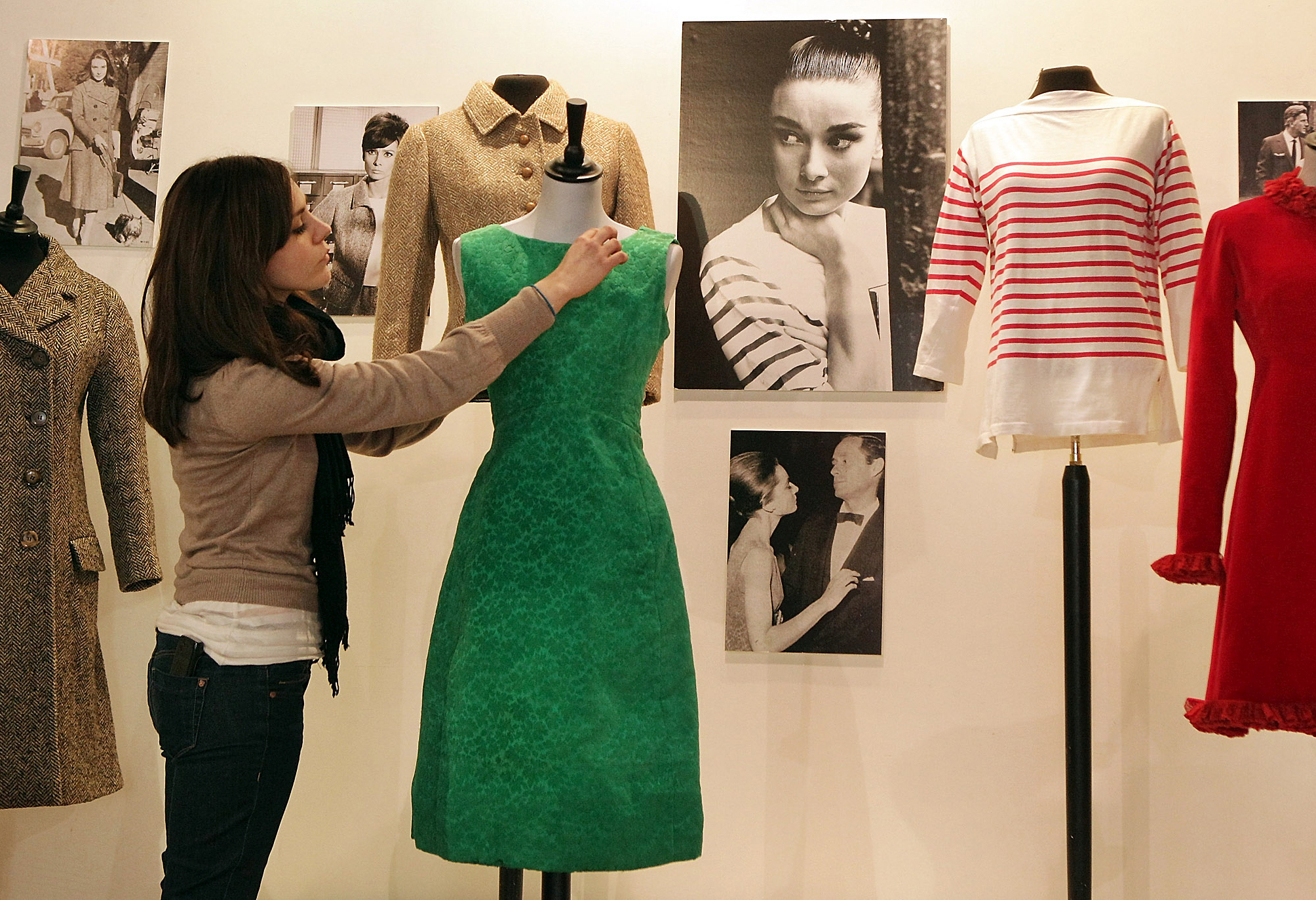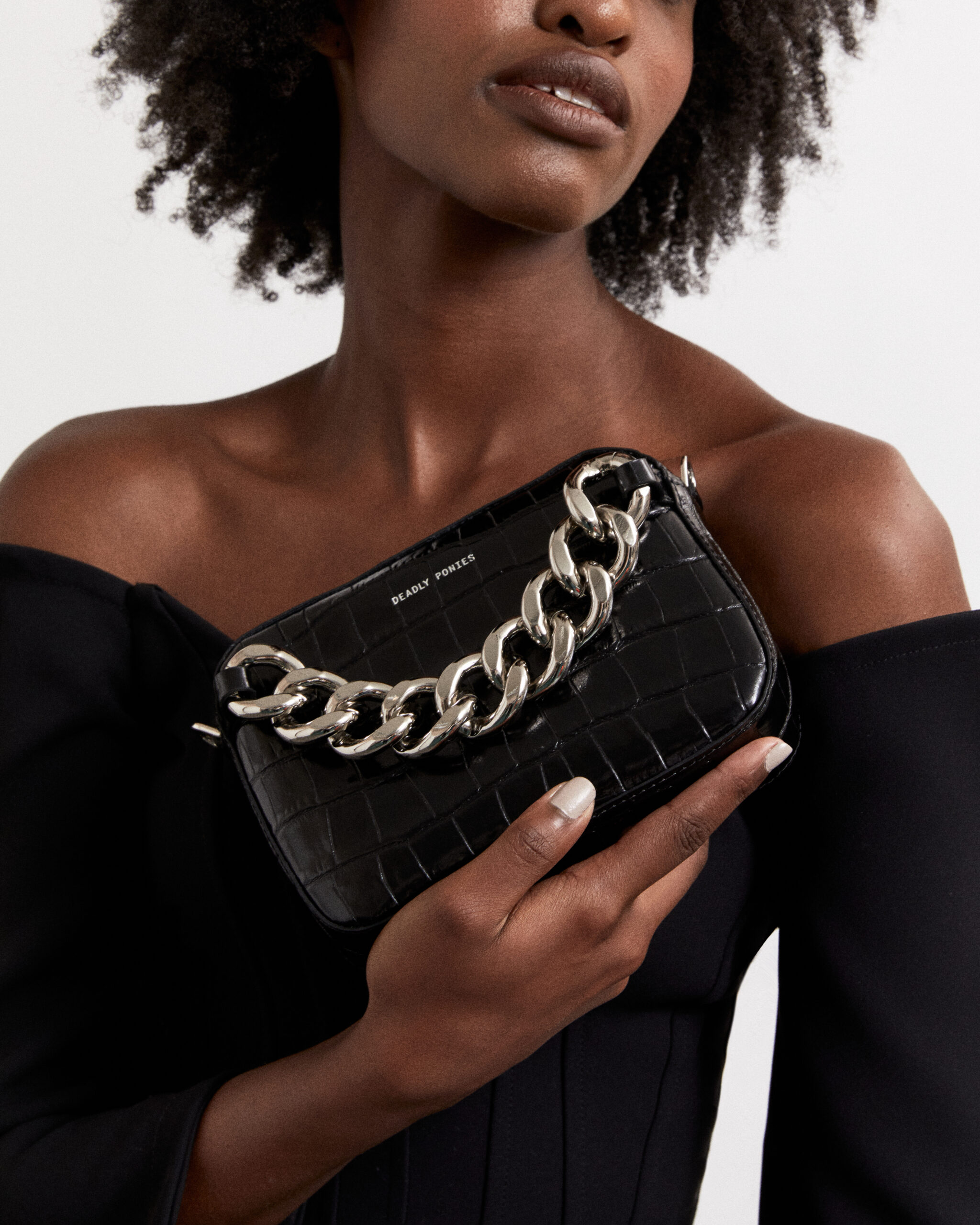As clothing prices have plummeted over the last ten years, we’ve bought more than ever before but typically spent far less on any one item. The nation’s wardrobes are bulging but these cheap new clothes may have come at a cost that’s far greater than what’s paid at the till. Rebekah White takes a look at the dark side of the fashion industry – and uncovers the secrets of enduring style.

It seems we’ve got a ravenous appetite for fashion. Garments are more than a third cheaper than they were ten years ago, and the average woman owns more clothing now than at any other time in history. It’s all thanks to ‘fast fashion’, a revolutionary new production model that’s taken the industry by storm.
The fast fashion concept first appeared in the late 1990s. By manufacturing garments in smaller batches and demanding that factories met ultra-quick turnaround times, retailers found they could get items on the shelves a mere few weeks after a new trend hit.
In the 1980s an average chain store would have received four collections a year, but by the mid-2000s, fast fashion chains were producing thousands of lines each season. For the first time, you could buy cheap versions of designer garments soon after the originals were first flaunted by celebrities or seen on the runway. It was haute couture for the masses: poor quality and rock-bottom prices. Think the House of G on steroids.
The result? Clothes have gone from being investments to being disposable items. In the UK, where fast fashion is at its most extreme, consumers buy two million tonnes of clothes each year, more than half of which ends up in landfill. That’s about 30kg of clothing and other textiles per person, per year. And though the full extent of fast fashion has not yet hit New Zealand, it’s coming. Powerhouses such as Zara and Topshop are currently expanding into this corner of the Pacific, putting pressure on local chains.
Challenging this onslaught of cheap, disposable garments is a growing brigade of style stalwarts. Fed up with fast fashion’s treadmill, these advocates of the slow fashion movement are looking for something quite different – lovingly crafted clothing made with luxurious fabrics and quality workmanship. These are garments that take longer than 48.5 seconds to create (the average time allowed for a T-shirt in one Bangladesh factory) and last longer than a season. Lucy Siegle, the British journalist and author of To Die For, is one high-profile champion of the cause.
Another slow style advocate is Mo Tomaney, a lecturer at London’s famed Central St Martins School of Fashion and Textiles. In Matilda Lee’s book Eco Chic, Mo describes when her mother, who earned £1.50 a week in a blue-collar job, spent £12 on a madeto- measure coat. It was 1949; today’s equivalent would be a Kiwi mum on a weekly income of $350 spending $2,775 on a coat.
It was a true investment. Mo was still wearing the coat more than 30 years later, long after her mother had handed it down. Fabulous heirloom garments are partly what slow style is all about.
The idea of slow fashion is closely akin to the hugely popular Slow Food movement founded by Carlo Petrini in Italy in 1986. Slow Food encourages people to spend time enjoying the pleasure of eating, as well as to develop an awareness of where their food is sourced. It champions diversity and opposes the standardisation of taste. Slow fashion is just one of many sister movements.

Plant your wardrobe with style perennials
There’s a reason why nearly 20 years after her death, actress Audrey Hepburn is still considered one of the most stylish women ever to have graced the planet. She favoured simple garments devoid of embellishment – a black three-quarter-sleeve top here, a well-cut pink frock there. In other words, clothing that remains chic year after year.
Audrey knew that timeless style is built on a few simple pieces. So the first step in becoming a slow fashionista is to figure out which wardrobe staples – those faithful basics – best flatter your figure. Should you invest in pencil or A-line skirts? Tapered or straightleg trousers? Your white tee, a classic must-have: should it be fitted, loose … or black?
Finding the key shapes for you requires a little experimentation (and an honest friend or two). Your goal is to develop a ‘uniform’ – a collection of go-to combos that flatter your figure. Maybe yours will involve dresses cinched at the waist, hip-length tunics layered over leggings or A-line skirts teamed with fitted cardigans.
Learn to splurge strategically
When a garment is extremely well made, it’s worth a splurge – provided it’s one of those key pieces that’ll get regular wear over the years. But an item’s expense doesn’t guarantee its quality. Even luxury brands are cutting corners, reports fashion journalist Dana Thomas in her book Deluxe: How Luxury Lost its Lustre. The trick is to shop like your grandma would have done: turn out the seams to see if they’re well finished or if threads are loose and the stitching is uneven. Is the garment lined – and not just with cheap polyester? Are heavy-use areas such as buttons or zips reinforced? Is the fabric durable? Heavier fabrics wear better – floaty chiffon is prone to snagging, and delicate textiles are costly to maintain if they’re dryclean-only.
Seek out brands creating long-life garments. Laurie Foon, founder of Wellington-based label Starfish, sees herself in the business of making future hand-me-downs. “Enduring style is most important to me when designing,” she says. “Our garments are passed on through people’s families and friendships and are still part of their lives.”
Flirt with trends – one at a time
Once you’ve got the essentials sorted, it’s easier to figure out which trends to incorporate into your wardrobe and which to leave on the rack.
It happens to all of us: that frock you fell in love with at first sight was worn for a season, then consigned forever to the ‘regrets’ pile in your wardrobe. Another became part of your regular outfit rotation. What’s the difference?
As a general rule, the more details a garment has, the more quickly it becomes outdated. Take stripes: they’ve been popular since the early 1900s when Coco Chanel first designed tops inspired by French fishermen. Right now, stripes are back. A simple striped tee will serve you well, but one with embellished shoulders and military-style buttons on the cuff will be giving off the whiff of an expired trend by this time next year. Fads are safest when a garment includes only one of them; if it incorporates several, pass it by.
Shop with a critical eye. If the current skirt length, the calf-length midi, is perfect for you, find a couple of good ones while they’re on the market. Do they make you look short or frumpy? Wait for above-the-knee skirts to come back. “If you have your own personal style, it’s not important what’s in or out of fashion,” says journalist Tamsin Blanchard in her book Green is the New Black. “If it’s part of your particular look, then you will want to wear it for as long as it gives you pleasure.”
Head off the beaten shopping trail
Building a great wardrobe needn’t break the bank. You’ll save a fortune (and find some real conversation pieces) by heading beyond the boutiques. Clothing is a fraction of its original price in op shops, Savemarts and second-hand stores. Forget the musty smell – it’s nothing a cycle in the washing machine can’t fix. And laying down $5 for an eye-catching full-circle skirt in perfect condition is going to be way more satisfying than buying one from a rack of twenty. Check out the NZ Op Shop Directory or Savemart for local stores. Craft markets also offer a cost-effective wardrobe fix, with handmade garments and vintage items repurposed as accessories.
If you’ve identified a gap in your wardrobe for a particular item, try Trade Me before hitting the mall. Set up a saved search for what you need and simply wait for the listings to roll in.
Learn the tricks of repurposing old favourites
Leading the slow fashion charge (or should that be waltz?) are women like Sheena Matheiken, who proved you can wear the same dress for an entire year and still look stylish. The Indian-born New Yorker refreshed her look with accessories that were preowned, vintage, recycled or donated. You can check Sheena’s 365 outfits at The Uniform Project, but be warned: you may experience style envy!
The key to preventing wardrobe boredom is to create fresh looks with unique, personal accessories. And, unlike that perfect pencil skirt, accessories are easy to find. Dig out your grandmother’s costume jewellery, pick up silk scarves from op shops for $1 a pop or find a unique handmade clutch at online craft market Felt. When you get bored of your stash, give it away or swap it among friends.
Don’t be afraid to modify garments that have become outmoded, or get a tailor to do it for you. Cut a dress down to a skirt, have a coat taken up to become a jacket, get your maxi skirt hemmed at a flirty length for summer or dye a tired white tee a fresh new colour. Alternatively, pack items away for a season or two. If they’re enduring classics they’ll keep for another day!
Support retailers who embrace the slow fashion ethos
What’s on your fashion wish list? Want to see higher quality fabrics and better workmanship? How about cotton that’s organic as opposed to conventionally produced? Or some kind of guarantee that the people who made the garment worked a normal week, rather than hours and hours of overtime?
Each garment you buy affects what kind of clothing retailers produce, says Fashion Industry New Zealand chief executive Mapihi Opai. “It all comes down to people and their spending power,” she adds. “The consumer is king – they vote with their wallets. No industry can ignore that.”
As a garment label tells us so little, it can be near-impossible to find out whether or not the people who dyed the fabric, cut and sewed it together received a fair wage and worked in a safe environment. But as shoppers we can reward retailers that are transparent about where and under what conditions their garments are made.
Kiwi brand Kowtow has a short film showing its clothes being manufactured – a rare insight into the industry. Kowtow founder Gosia Piatek took a camera along when she visited her Kolkata factory, a workplace where employees enjoy the kinds of benefits New Zealanders take for granted. “Their children go to school for free,” she says. “They have paid lunch breaks, no overtime, a medical fund, holiday leave and sick leave, and a modern, safe facility.” If a brand doesn’t publish information about its supply chain, ask how much its garment workers are paid and how long they work. (For bonus points you could throw in, ‘Can they join a union?’ or ‘Do you visit your factory yourself?’)
The only way you can determine from the label alone that the person who put the garment together wasn’t exploited is if it says ‘Made in New Zealand’. And onshore manufacturing has an extra bonus: it helps preserve the Kiwi skill base and industry. “It really makes sense to me to use the guy down the road,” says Laurie Foon of Starfish, which manufactures all its garments on home ground. “That way the infrastructure is there for the next generation of designers coming through. It’s like preserving an heirloom.”
The dark side of fashion
Fashion is fun. There’s nothing like the thrill of finding something that makes you look and feel great. But the industry’s hidden side is anything but light and whimsical. Here are 12 things Rebekah White really hates about fashion:
1. Disposable clothing
You’ve got to sacrifice something to make ultra-cheap frocks: quality. Cheap clothing wears out quickly and is consigned to landfill after barely a season. Let’s not see the humble hand-me-down turn into an endangered species.
2. Knock-offs of other people’s style
Sure, I could pick up a replica of Alexa Chung’s latest sundress at ASOS (As Seen on Screen) a mere few weeks after she was snapped wearing it – but we have enough sheep in this country already.
3. Plastic fabric
I recently discovered that my floaty polyester summer dress began life as sludgy, black crude oil. Polyester (and its synthetic cousins, acrylic and nylon) is cheap, it doesn’t crease and it’s really durable – a little too durable, in fact. Taking about 200 years to decompose, my polyester garments will be sticking around for an awfully long time after they’ve left my wardrobe.
4. Fast fashion’s vicious cycle
Retailers want stock on their shelves as soon as a new fad hits, and at lower prices than their competitors – so factories are forced to turn around orders faster than ever, or risk losing business. A factory struggling to meet a deadline may subcontract to another facility that hasn’t been audited (meaning it probably offers a less-than-fantastic working environment) or to home workers, who’re not usually protected by labour laws. Ultimately, the people who lose out are the garment workers themselves, working longer and longer hours for little or no increase in pay.
5. Vague garment labels
What I find frustrating about those little care labels is that they don’t tell me what I most want to know. ‘Made in China’ doesn’t reveal how much the person who stitched the garment together was paid or if they could afford to put food on the table for their kids. And if that fact is in doubt – as it is for most countries where garments are produced – then I’m reluctant to open my wallet.
6. Gasps when celebs wear something twice
Is it really news when Kate Middleton dons a jacket for the second time? We know we’ve made a right royal purchase when our frock makes us look as fabulous on its twentieth outing as it did on its first.
7. The minimum wage in Bangladesh
It’s easy for retailers to boast that their employees are paid at least the minimum wage – it’s so low in countries like Bangladesh that garment workers need to take on overtime just to make ends meet. Since 2008, international action groups including Labour Behind the Label and War on Want have been pushing for big British brands to pay a ‘living wage’ – one that allows employees to buy nutritious food, clean water, shelter, clothes, education, health care and transport. Despite promises on paper from some, including the owners of Topshop, this hasn’t happened yet.
8. Responsibility-dodging by retailers
Some big-name brands say it’s not up to them to pay garment workers more – it’s up to governments to increase the minimum wage. But if one nation raises it, what’s to stop retailers from simply moving their business to the country next door where labour is cheaper?
It’d be pretty awesome if all these underpaid workers could get together and bargain for higher wages. Unfortunately, as Labour Behind the Label reports, you’d probably be fired for joining a union if your supervisors found out – and if named a troublemaker, you could have difficulty finding a job anywhere else.
9. Warning factories of upcoming inspections
You’re a factory owner and you’ve just been told you’ll be audited next week. What do you do? Here are some ideas from fellow factory owners: unblock the fire exits, hand out safety equipment, hide the child workers in a separate room, fiddle with the payroll records, install a fake toilet and warn employees exactly what will happen to them if they voice their concerns. Anyone can comply with a code of conduct – for a day.
10. Dying for cotton
Cotton’s a fragile little plant – it’s susceptible to about 1,300 types of worms, weevils and bugs. Farmers can’t afford to lose even a fraction of their crops, so they employ an arsenal of toxic pesticides. These are pretty lethal – one drop of Aldicarb (the second most popular one) absorbed through the skin is enough to kill an adult. And it does. The World Health Organization estimates up to 40,000 people die each year from pesticide poisoning and another million need hospital care.
11. International back-scratching
Pesticides aren’t the only difficulty cotton farmers face – the global market is rigged in favour of First World producers. The US offers massive subsidies to its farmers, enabling them to sell their crops below the cost of production, thus undercutting other producers and pushing down the global price of cotton.
The scale of these subsidies is mind-boggling: almost $5 billion a year. That’s more than all US aid to Africa – and more than the total national wealth of cotton-reliant African nation Burkina Faso, says Fairtrade campaigner Harriet Lamb in her book Fighting the Banana Wars. It’s been estimated that getting rid of US subsidies would increase the income of West African farmers by five to 12 percent.
12. The vanishing sea
The problem with the Aral Sea is that it no longer exists. Well, not like it used to. It’s about 15 percent of the size it was in the 1980s, and its native marine life has completely vanished. Why? The two rivers that feed it have been diverted to irrigate Uzbekistani farms producing – you guessed it – cotton. As Lucy Siegle reports in To Die For, cotton’s a thirsty crop, requiring between 11,000 and 20,000 litres of water just to produce enough textile for one pair of jeans.







